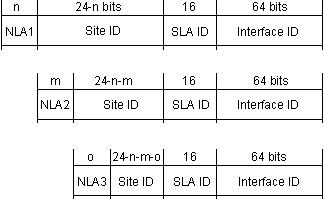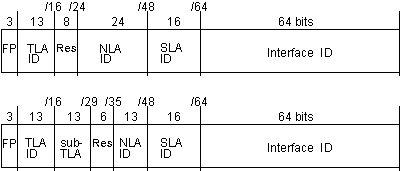3 Special Issue: IPv6 Japanese Page
Announcement of IPv6 sub-TLA application agent service
On January 20, 2000 JPNIC began accepting applications for IPv6 sub-TLA address allocations. Furthermore, it became possible, starting from March 1, to register name servers with an IPv6 address in the JP domain DNS. This article serves brief explanation of IPv6 and its address architecture, and also describes the background and contents of the services offered by JPNIC.
1. What is IPv6?
IP (Internet Protocol) is a body of defined communication procedures on which the Internet is based. The protocol in current Internet use is IP version 4 (IPv4 hereafter). IPv4 may be regarded as the key technology which has been supporting the Internet from its infancy.
As you know, the Internet user population is expanding explosively, with the fields of application diversifying widely. Some arguments have been made pointing to the possibility that, with this situation, IPv4 may not be able to support the Internet in the future. Some of the challenges facing IPv4 include constraints on the amount of available IP addresses, constraints on routing, heavy burden on routers, and other issues. Also, there are several requests to add various functions for supporting new service fields.
The newly designed protocol, intended to resolve such problems attributable to the constraints of IPv4 and in response to calls for functional upgrades, is IPv6 (IP version 6).
2. IPv6 Address Architecture and Allocation
The address capacity of IPv6 represents an expansion from the 32-bit capacity of IPv4 to 128 bits, a four-fold increase in terms of length and an increase by 2 to the 96th power in terms of address space. Under IPv4, the length of the network component was variable, determined either by class or with the use of a technology known as CIDR, but under IPv6 the length is fixed at 64 bits. The lower tier of the 64 bits is reserved for host-specific (more precisely, interface-specific) addresses.
The 128-bit address is structured as shown below. Address allocation is handled by the TLA ID (top-level aggregation identifier) and the NLA ID (next-level aggregation identifier). The assignment to the end-site is done with /48 as the smallest unit (the first 48 bits being designated by the top-level provider). In the end-site, the remaining 16 bits of SLA ID (site-level aggregation identifier) may be used to build an intra-organization subnet.

In the address allocation hierarchy, an RIR[*1]allocates TLA space to the organizations that constitute the backbone of the Internet; the TLA organizations then allocate NLA space to the organizations under their jurisdiction.
NLA allows for the building of a further hierarchical structure within the 24-bit space, the resulting allocation being connected from TLA to NLA1, from NLA1 to NLA2, etc. How many bits to use for allocation to the top-level NLA will be left to the discretion of the TLA organizations; what use to make of the remaining portion of the allocated NLA space will be left to the discretion of the NLA organizations.

3. What is IPv6 sub-TLA?
The highest-order unit of allocation under IPv6 is TLA, which, with /16, is in itself a very large unit. The IPv6 network has just started operating; based on the thinking that, given such circumstances, address assignment should be handled with utmost attentiveness, a /29 sub-TLA block (sTLA) has been instituted as an allocation sub-unit under TLA. In actual practice for now, the sTLA space allocation is /35, which includes the reserved space.

As mentioned in the preceding paragraphs, IPv6 utilization does not require to acquire sTLA. The sTLA is placed in the highest-level route aggregation, from where address allocation to lower-level NLA is performed. Given that the NLA is capable of housing a plurality of layers, it may happen in certain cases that the NLA organization allocates addresses to the lower-level NLA2. Address assignment to the end-site is performed by the sTLA and NLA organizations.
Criteria have been established by the RIRs that deal with sTLA allocation issues, and allocation approval/non-approval is determined through judgement by each RIR. For more specific information, please refer to the policy document regarding IPv6 assignment and allocation[*2]as well as JPNIC's Web site.
4. Background to the Start of IPv6 sTLA Application Acceptance
It is the RIR that handles IPv6 sTLA allocations, and organizations wishing to utilize IPv6 through acquisition of an sTLA should submit their applications to an RIR. In our region, the RIR will be APNIC. APNIC provides allocation only to organizations that are APNIC members. Because JPNIC is an APNIC member, if a JPNIC member organization becomes an APNIC member and submits its sTLA application, this will result in double membership registration.
JPNIC represents its members as a member of APNIC (under a "confederation" arrangement). Under this setup, JPNIC has been coordinating with APNIC to enable JPNIC members to submit their sTLA applications to the APNIC through JPNIC.
The coordinating work was completed by December 1999, and we were able to make public the contents of the service at Internet Week 99 held in December. Then we have started to accept sTLA allocation applications since January 20, 2000.
5. Contents of the IPv6 sTLA Application Acceptance Service
As sTLA allocation is handled by the RIRs, JPNIC provides agent services to forward the applications submitted by JPNIC members to APNIC. The sequence of procedures JPNIC members follow in submitting their sTLA applications will be as follows:
(1) Acquisition of APNIC handle and registration of maintainer object.
(2) Completion of sTLA application form on JPNIC's Website, entering all relevant items.
(3) The form as entered by applicant will be returned to applicant by E-mail. Applicant will verify its contents and send it to the applications acceptance desk at JPNIC.
(4) JPNIC will send an E-mail confirming applicant's intentions and application form contents. Applicant will respond.
When the above-described steps are completed, the sTLA application will be accepted. There are a few points to pay attention to in this process:
Regarding (1): When submitting the sTLA application, the applicant must have already registered in APNIC's database the names of persons who will be the "admin-c" and the "tech-c" for IPv6 network information. These names will then be permanently registered in the APNIC database. For further procedural details, refer to APNIC's Web site.
Regarding (2): When entering the required information on the application form, the applicant must be sure to complete all entries in English. JPNIC does not undertake the translation into English of the contents of the application form. This is to avoid all possible misrepresentation of the originally intended meaning of the applicant's entries.
Regarding (4): Only upon confirmation of the applicant's intentions will JPNIC proceed to accept and process the applicant's sTLA application.
Upon acceptance of a member organization's sTLA application, JPNIC will forward it to APNIC. APNIC will judge the contents of the application and may, as necessary, ask questions. Here too, JPNIC will relay the question-and-answer correspondence. All communications will be conducted in English.
When it is judged that the contents of an application satisfy the sTLA allocation criteria, the allocation will be proceeded to.
When an allocation has been granted, JPNIC will proceed to collect handling charges. If an application has been rejected, no charges will be assessed. The amount of the charges for /35 sTLA allocation is \50,000 yen as of March, 2000. Let it be understood that this amount is subject to change in the future as dictated by changes in APNIC's handling charge, service scope and other factors.
The sTLA application handling fee will be charged as one of the items on the bimonthly service delegation invoice.
For further procedural details, please refer to "IPv6 sub-TLA Allocation Application Web"[*4].
6. Registration of name servers which have IPv6 addresses to the JPNIC database and the JP DNS server
Effective March 1, it has become possible to register IPv6 address-holding name server information to the [Host Information] section of JPNIC's database. With this development, the [IPv6 Address] item of [Host Information] will now be displayed in WHOIS. Furthermore, this IPv6 address will be registered as an AAAA resource record in the name server administered by JPNIC. For further details, please refer to the Registration Guide[*5].
Currently, the JP Primary Domain Name Server only allows connection by IPv4 addresses; connections by IPv6 addresses cannot be made directly. JPNIC has been studying the situation, towards providing IPv6 connectivity to the DNS.
7. Conclusion
All inquiries to JPNIC regarding IPv6 should be submitted to the following address. Please do not hesitate to contact us with opinions, requests and comments.
[*1] RIR:Regional Internet Registry. As of 1999, three organizations, APNIC, RIPE-NCC and ARIN, are recognized as regional registries.
[*2] "PROVISIONAL IPv6 ASSIGNMENT AND ALLOCATION POLICY DOCUMENT"
http://www.apnic.net/docs/ipv6-policy.html
A Japanese translation prepared by JPNIC is also
available for reference (IPv6 Assignment and Allocation
Policy Document).
http://www.nic.ad.jp/jp/internet/doc-j/ipv6/v6-rir-policy.html
ftp://ftp.nic.ad.jp/jpnic/translation/v6-rir-policy.txt
[*4] http://www.nic.ad.jp/jp/regist/ipv6/index.html
[*5]http://www.nic.ad.jp/jp/regist/db/doc/db-guide-v6.html




